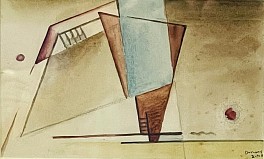BIOGRAPHY

German-American (1899-1985)
Considered to be one of the founding fathers of American abstraction, Werner Drewes was one of the first artists to introduce concepts of the Bauhaus school within the United States. Born in Germany, he spent several years at the famous Bauhaus design school studying with Paul Klee and Wasiliy Kandinsky. In 1933, when the Nazis closed the Bauhaus, Drewes emigrated to the U.S. There he became an ardent proponent of abstract painting. His work can be found in the collections of the Whitney Museum, MOMA, the MET, the Brooklyn Museum and the Museum of Fine Arts, Boston.
It is impossible to underestimate the importance of the Bauhaus to 20th Century art, design and architecture. The German Bauhaus school was by many accounts the most influential modernist art school of the 20th century, one whose “radical approach to art in all its forms” made it “a philosophical center comparable to the Garden of Epicurus,” according to Tom Wolfe in From Bauhaus to Our House (1981). In the United States, its significance spread in large part due to the influence of Werner Drewes, painter, printmaker, teacher, and graduate of the Bauhaus diaspora.
Drewes became a US citizen in 1936. In 1937, he and Bauhaus artists, including Piet Mondrian and Lyonel Feininger, founded the American Abstract Artists group, the first formal organization in the US devoted to non- objective art. He exhibited at the Museum of Modern Art and elsewhere.
In 1944 and 1945 Drewes worked at Stanley William Hayter’s Atelier 17, where he first experimented with color printmaking; the two are often credited with improving the color intaglio technique.
A tenured position at Washington University in St. Louis came a year later, where he fine-tuned his interpretation of the Bauhaus aesthetic with unique printmaking techniques, a daring use of color, and woodcuts. He retired from the university in 196
